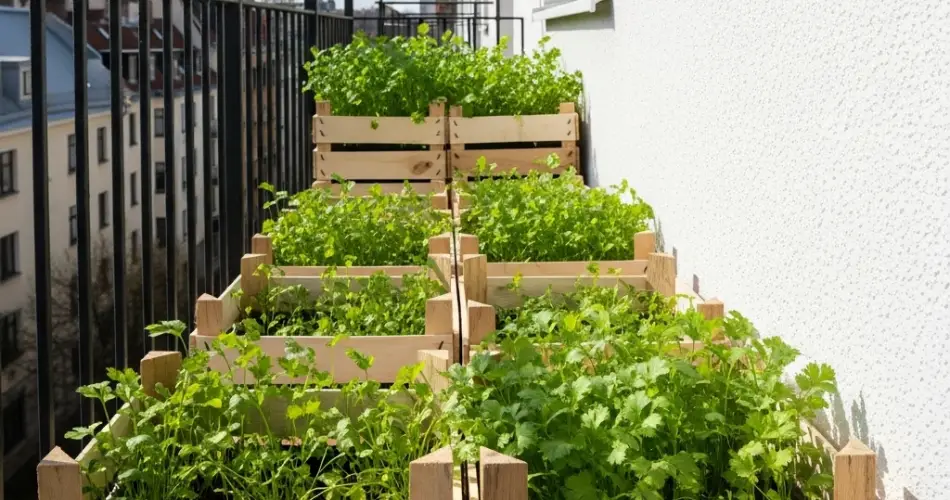Cilantro, also known as coriander, is a fresh, fragrant herb widely used in a variety of cuisines—from Asian and Latin American to Mediterranean dishes. Its zesty leaves and aromatic seeds make it a dual-purpose plant worth growing at home. Fortunately, cilantro is easy to cultivate, even in small spaces. With a sunny balcony and a simple crate, you can enjoy a steady supply of this versatile herb throughout the growing season.
Here’s a step-by-step guide to growing cilantro in crates on your balcony.
Why Grow Cilantro in Crates?
Crates are ideal for small-space gardening. They offer enough depth for herbs with moderately long roots like cilantro and allow for good drainage, which is essential to avoid soggy soil. Growing cilantro in a crate also helps manage space efficiently, especially in urban environments where ground planting is not an option.
Additionally, crates are portable—you can move them to follow the sun or protect your plants from harsh weather.
Materials You’ll Need
-
A wooden or plastic crate (at least 12 inches deep)
-
Landscape fabric or plastic liner
-
Quality potting mix
-
Organic compost or aged manure
-
Cilantro seeds
-
A watering can with a gentle spout
-
Hand trowel
-
Spray bottle (optional)
Step 1: Prepare the Crate
Start by lining the inside of the crate with landscape fabric or a plastic sheet. This will keep the soil in while allowing excess water to drain. Be sure to poke holes at the bottom if you’re using plastic.
Set the crate in a sunny spot on your balcony. Cilantro thrives in full sunlight—ideally, 5 to 6 hours a day—but it can tolerate partial shade, especially during the hotter months.
Step 2: Make the Perfect Soil Mix
Cilantro grows best in light, well-draining soil that’s rich in organic matter. Mix together:
-
2 parts quality potting mix
-
1 part compost or aged manure
-
A small amount of sand or perlite (optional, for extra drainage)
Fill the crate with this mixture, leaving about an inch at the top to make watering easier and to prevent runoff.
Step 3: Sowing Cilantro Seeds
Cilantro is best grown from seed rather than transplants, as its long taproot doesn’t tolerate moving well. Sow seeds directly into the crate by scattering them evenly or planting in rows about 1/4 inch deep.
Cover lightly with soil and water gently using a fine spray. Keep the soil consistently moist but not waterlogged until germination, which usually takes 7–10 days.
To ensure a continuous harvest, sow seeds every 2–3 weeks in new sections of the crate or in additional crates.
Step 4: Care and Maintenance
Watering:
Cilantro prefers evenly moist soil, especially during its early growth stages. Water regularly, particularly in hot or windy conditions, but avoid soaking the soil.
Sunlight:
In cooler weather, give cilantro full sun exposure. During peak summer, some afternoon shade helps prevent premature bolting (when the plant goes to seed too early).
Thinning:
Once seedlings are a couple of inches tall, thin them out to allow about 2–3 inches of space between each plant. This promotes better air circulation and stronger growth.
Feeding:
Cilantro doesn’t require heavy feeding. Apply diluted compost tea or an all-purpose organic fertilizer once a month if your soil mix lacks nutrients.
Pest Control:
Cilantro is relatively pest-resistant but may occasionally attract aphids or whiteflies. A gentle spray of water or neem oil can help keep pests in check.
Step 5: Harvesting
You can begin harvesting cilantro leaves when the plants are about 6 inches tall. Use scissors to snip the outer leaves first, allowing the center to continue growing.
For the best flavor, harvest early in the morning when the oils are most concentrated. Don’t let the plant grow too tall before harvesting, as it may become bitter and bolt quickly.
If the plant does bolt and produce flowers, let it mature—this will result in coriander seeds. Collect the seeds once the seed heads dry out and turn brown. Store them in a dry container for culinary use or future planting.
Extra Tips for Success
-
Keep replanting every few weeks for a constant supply of fresh leaves.
-
If temperatures are too hot, try placing the crate in a slightly shaded area to reduce the risk of bolting.
-
Avoid fertilizing heavily, as too much nitrogen will result in lush leaves with weaker flavor.
-
Trim flowering stems promptly unless you plan to harvest coriander seeds.
Conclusion
Cilantro is a fast-growing, flavorful herb that fits perfectly into a balcony gardening routine. With a simple crate, good soil, and regular care, you can enjoy fresh cilantro leaves and seeds without needing a traditional garden. Whether you’re spicing up salsa, soups, or curries, having your own homegrown cilantro is a delicious and satisfying reward.



